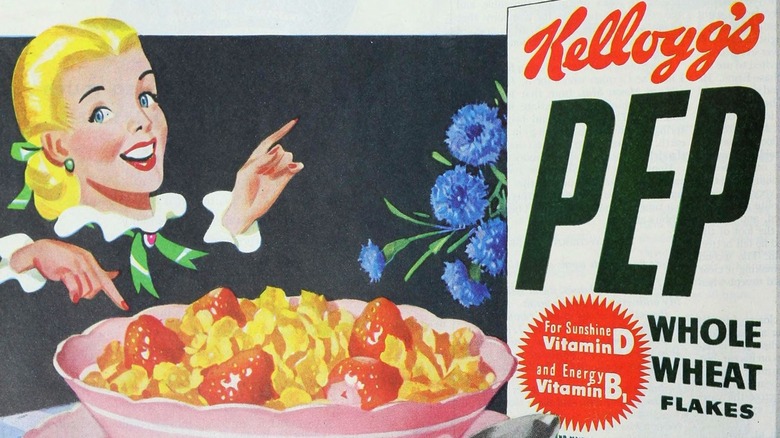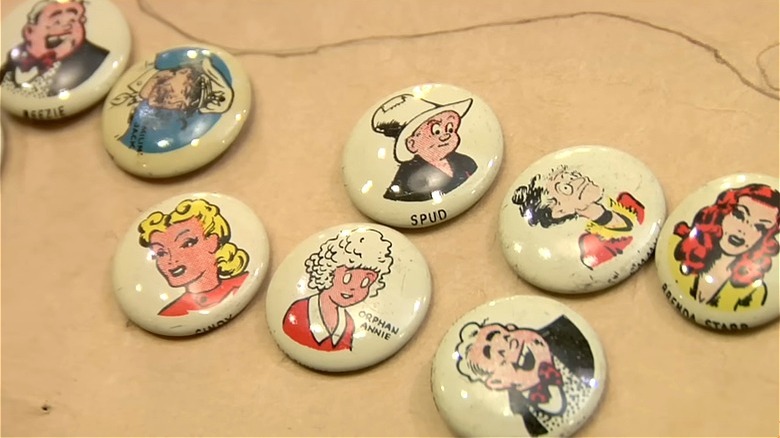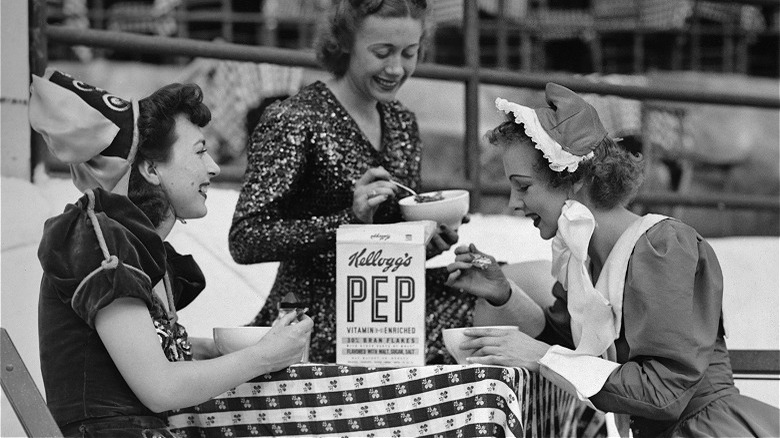The Unexpected Value Of A PEP Cereal Box Today
The road to Kellogg's PEP cereal, which made its debut in 1923, began in the mid- to late-19th century with the invention of breakfast cereal. Although some aspects of the cereal origin story are murky, it's widely accepted it started in 1863. The invention, called "granula" and created by Dr. James Caleb Jackson of New York, was a hardened graham dough that was crumbled into pieces before serving (according to The New York Times Magazine, the baked dough was "edible only when soaked in milk overnight"). Not long after this, Dr. John Harvey Kellogg of Michigan created a similar mixture of wheat flour, oatmeal, and cornmeal, which he also called granula but would eventually rename to "granola" following a lawsuit by Jackson. Then, in 1898, a failed batch of Kellogg's granola gave way to the first corn flakes.
After World War II, cereal makers like Kellogg's began advertising their wares on a new format: television. No longer just a health food staple, cereal manufacturers now marketed cereal to children. Besides adding a large dose of sugar into the equation, the boxes that cereal came in also received a makeover. Heavily decorated boxes often featured cartoon or comic book characters (check out the most valuable comic ever sold), as well as celebrities and sports heroes. To supplement the eye-catching packaging, a small prize was frequently contained within.
Of particular value to collectors today are boxes that once contained PEP, a cereal introduced by Kellogg's in 1923 to compete with popular rival Wheaties. Besides the boxes themselves, collectors also clamor for prizes that were inside PEP boxes, including a series of buttons featuring popular characters of the time.
[Featured image by Wyeth, NC via Wikimedia Commons | Cropped and scaled | No restrictions]
PEP pins are worth a bundle, too
More than a decade ago, a collection of PEP pinback buttons (partly featured above) was scrutinized on the popular reality TV show "Pawn Stars." An expert appraised the collection of cereal prizes at a value up to $800. Of course, the pawn shop (BTW, beware that pawn shop loans are among the loans that will keep you poor forever) only paid about half that amount to leave themselves room to profit from reselling the collectibles.
Around the same time that the PEP pinback buttons were making their appearance on "Pawn Stars," another even larger set was put up for bidding on the Heritage Auctions website. The buttons, which hailed from 1945 to 1947, featured Superman, as well as "different comic strip characters, like Little Orphan Annie, Felix the Cat, [and] the Phantom...," according to the seller. In February 2012, the entire set of 90 buttons sold for an impressive $1,673.
While over $1,000 for a button collection is nothing to sneeze at, some cardboard PEP boxes have sold for even more than that amount. Starting off a little more modestly, let's take a look at a PEP box from 1945. It features both Superman and Dick Tracy on the box as potentially appearing on the button-pin prize contained within. On the rear of the box is a large artwork with factoids about Uncle Sam's Paratroopers. This box, said to be in very good condition, sold for $372 in December 2022.
Certain PEP boxes can eclipse $2,000
Apparently, some of the later PEP cereal boxes are among the most valuable. By the 1960s, the Wheaties competitor was likely already declining in popularity — it was discontinued in the 1970s — but that era produced some of the most valuable and rare boxes. An expert on collectibles, Tony Hyman, tells CBS News, "One of the most valuable boxes from a collector's standpoint is a PEP cereal box from the early 1960s, now worth $2,000. Another box featuring the Beatles goes for $2,000 to $3,000." Of course, some actual Beatles vinyl records are worth even more.
Hyman continues that the most valuable boxes will typically contain images of celebrities, sports stars, or characters from a cartoon series. PEP isn't the only cereal with a desirable container, though. A 1937 cereal box from competitor Wheaties sold for more than $1,500. What was so special about it? Baseball great Joe DiMaggio graced the front. Similarly, a 1951 Wheaties box featuring another baseball star, "Stan the Man" Musial, fetched over $1,200.
If you think you have a rare cereal box in your pantry, definitely first dump the cereal itself. That's because, eventually, small insects will grow inside. Once those insects polish off the cereal, they'll graduate to eating the box itself, destroying its value. After jettisoning the cereal, you can re-seal the box and display it. Alternatively, open all the flaps and carefully fold the box flat so it will occupy less storage space.


